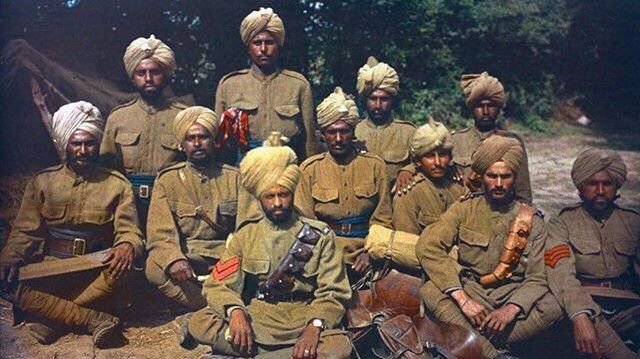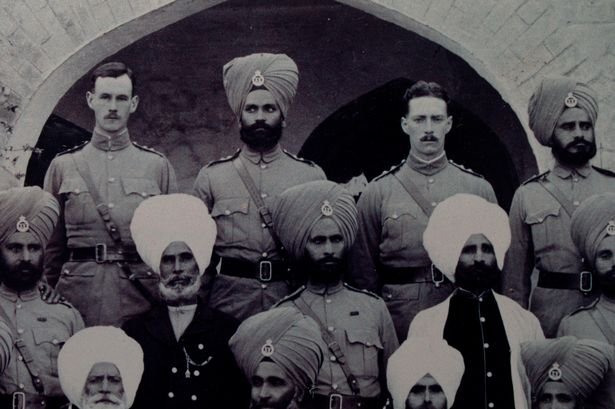Gagan damaamaa baajiou pariou neesaanai ghaao khaet ju maandiou soormaa ab joojhan ko daao (1105)
(The battle-drum beats in the sky of the mind; aim is taken, and the wound is inflicted.
The spiritual warriors enter the field of battle; now is the time to fight!)
The ‘Battle of Saragarhi’ does not have parallels in the history of warfare. The supreme sacrifice of life by Havaldar Ishar Singh, along with 20 other Ranks of the 36 Sikh Regiment (now 4 Sikh) is a matter of pride for Sikhs in particular and the Indian Army in general. It is the epitome of Valor, Courage, Bravery and Supreme Sacrifice, where all 21 men literally fought ‘Last man last Round’, rather than surrender. It is one of the eight stories of collective bravery published by UNESCO. It has been mentioned as one of the five most significant events of its kind in the world, which include the Saga of Thermopylae associated with the heroic stand of a small Greek force against the mighty Persian Army of Xerxes in 480 B.C. Even to this day, this battle forms part of the school curriculum in England and France.
The plaque describes the unparalleled act of Bravery. Noteworthy features of the ‘Battle of Saragarhi’ that has earned a place of pride in the world are:
•21 soldiers of 36 Sikh Regiment (Now 4 Sikh) gave up their lives fighting an overwhelming enemy force of over 10,000 equipped only with their personal weapons (rifles) and limited ammunition.
•They chose to die rather than surrender.
“The English as well as Indian subjects are proud of 36 Sikh regiment and it is no exaggeration to record that the armed forces which possess valiant Sikhs cannot face defeat in war”-The British Parliament.
•Fearlessly they fought the enemy. Though the post fell, they emerged victorious in battle.
•Details of the battle are considered very accurate as Gurmukh Singh had been continuously signaling the progress of battle to Col. Haughton stationed a few miles away in Fort Lockhart He sought permission from the Battalion HQ to close down the heliograph equipment, take up his rifle and join the fight. He died fighting, after killing 20 enemy soldiers.
•The enemy conceded 180 dead, battle casualties of the enemy exceeded 600.
•All the 21 great warriors were awarded the Indian Order of Merit Class III (posthumously), which at that time was one of the highest gallantry awards given to Indian troops.
Nischey kar Apni Jeet Karon
(With firm resolve I attain victory).
The saga of bravery is being taught in schools in UK and France and now in Punjab.
The battle figures as one of the eight stories of collective bravery of the kind in the world published by UNESCO.
Saragarhi is the incredible story of 21 men of 36 Sikh Regiment (now 4th Battalion – the Sikh Regiment), who sacrificed their lives in devotion to their duty. On September 12, 1897, 21 Sikhs fought with 10,000 Afghans, Orakazai and Afridi tribesmen until their last breath defending their post.
It has been noted as one of the five most significant historical events of its kind, which includes the Saga of Thermopylae, with the heroic stand of a small Greek force (300 men) against the mighty Persian Army of Xerxes in 480 B.C. UNESCO (United Nations Educational, Scientific and Cultural Organization) has described the Battle of Saragarhi as one of eight stories of collective bravery in world history. The 4th Battalion was positioned at Saragarhi to provide heliographic communications between Fort Lockhart and Fort Gulistan. As the enemy moved closer to Saragarhi, the 21 Sikh soldiers were aware of the grimness of their position and refused every offer to surrender by the Afghans Meanwhile, the enemy set ablaze the area surrounding Saragarhi and made a breach in the wall of the signalling post. The soldiers ran out of ammunition and they continued fighting with their hands. On September 12 1897, all 21 Sikh soldiers laid down their lives to the last man defending their post. The attacker’s later conceded to have lost over 180 men in the battle. When news of the battle reached London, both Houses of Parliament gave a standing ovation in honour of the 21 Sikhs.

Of courage and bravery A tale be told
Long forgotten, brought forth From the memories of the old.
Of 21 men who Died at duty’s call
Who laid down their lives And let not the fort fall.
‘Twas the year 1897
The Battle of Saragarhi was waged, 10,000 Afghans, 21 Sikhs
Yet for hours the battle raged.
Outnumbered and surrounded And still the men fought on
With a stubbornness and pride for which, The Sikhs have long been known.
Charge after charge was repulsed And nary a bullet was wasted And though the battle was lost,
It was victory that the men tasted.
Now, the defenders ranks were dwindling And the ammunition would soon be over.
The wall was breached; the gate was rushed, It was the final hour.
Hand-to-hand fighting followed As the men fell one by one
And each took sawa lakh with him Before he was done.
A handful of men, a fort of stones, Mud walls and a wooden door
But when the last man had fallen, 180 of the enemy were dead, The wounded many more.
Under Havaldar Ishar Singh,
They fought to the last man, last breath They’d promised their all to the motherland And fulfilled the promise with their death.
And the world stood up to honour The heroic deeds of 21 men
That challenged the annals of history To tell of more glorious action, if it can.
Today we forget our history
As we sway to foreign music and dance While they teach the Battle of Saragarhi To the students in far off France.
And we know not the men of Saragarhi While the UNESCO includes their tale
In the 5 most significant events of its kind Collective bravery on the highest of scale.
And we remember not the men of Saragarhi- The men who took a stand.
And we care not for the men of Saragarhi Who laid their lives for our land.
The background
Saragarhi is a small village in the border district of Kohat, situated on the Samana Range, in present day Pakistan. On the 20 April, 1894, the 36 Sikh Regiment of the British Army was created, under the command of Colonel J. Cook. In August 1897, five companies of the 36 Sikh under Lt. Col. John Haughton, were sent to the North West Frontier Providence, stationed at Samana Hills, Kurag, Sangar, Sahtop Dhar and Saraghari.

The British had partially succeeded in getting control of this volatile area. However, tribal Pashtuns attacked British personnel from time to time. Thus a series of forts, originally constructed by Maharaja Ranjit Singh, Ruler of the Sikh Empire, were consolidated. Two of the forts were Fort Lockhart, (on the Samana Range of the Hindu Kush mountains), and Fort Gulistan (Sulaiman Range), situated a few miles apart. Due to the forts not being visible to each other, Saragarhi was created midway, as a heliographic communication post. The Saragarhi post, situated on a rocky ridge, consisted of a small block house with loop-holed ramparts and a signaling tower.
A general uprising by the Afghans began there in 1897, and between 27 August – 11 September, many vigorous efforts by Pashtuns to capture the Forts were thwarted by 36 Sikh regiment. Insurgent and inimical activities had increased, and on 3 and 9 September Afridi tribes, with allegiance to Afghans, attacked Fort Gulistan. Both the attacks were repulsed, and a relief column from Fort Lockhart, on its return trip, reinforced the signaling detachment positioned at Saragarhi, increasing its strength to one Non-Commissioned Officer (NCO) and twenty troops of Other Ranks (ORs).
On September 12, 1897, 10,000 Pashtuns attacked the signaling post at Saragarhi, so that communication would be lost between the two forts.
The battle
Details of the Battle of Saraharhi are considered fairly accurate, due to Gurmukh Singh signaling events to Fort Lockhart as they occurred.
•Around 9am, around 10,000 Afghans reach the signaling post at Saragarhi.
•Gurmukh Singh signals to Col. Haughton, situated in Fort Lockhart, that they are under attack.
•Colonel Haughton states he cannot send immediate help to Saragarhi.
•The soldiers decide to fight to the last to prevent the enemy reaching the forts.
•Bhagwan Singh becomes the first injured and later Lal Singh was seriously wounded.
•Soldiers Lal Singh and Jivan Singh reportedly carry the dead body of Bhagwan Singh back to the inner layer of the post.
•The enemy break a portion of the wall of the picket.
•Colonel Haughton signals that he has estimated between 10,000 and 14,000 Pashtuns attacking Saragarhi.
•The leaders of the Afghan forces reportedly make promises to the soldiers in order to entice them to surrender.
•Reportedly two determined attempts are made to rush the open gate, but are unsuccessful.
•Later, Fort Lockhart is breached.
•Thereafter, some of the fiercest hand-to-hand fighting occurs.
•In an act of outstanding bravery, Ishar Singh orders his men to fall back into the inner layer, whilst he remains to fight. However, this is breached and all but one of the defending soldiers are killed, along with many of the Pashtuns.
- Gurmukh Singh, who communicated the battle with Lt. Col. John Haughton, was the last Sikh defender. He is stated to have killed 20 Afghans; the Pashtuns having to set fire to the post to kill him. As he was dying he was said to have yelled repeatedly the regimental battle-cry: Bole So Nihal, Sat Sri Akal (He, who cries God is Truth, is ever victorious).
Having destroyed Saragarhi, the Afghans turned their attention to Fort Gulistan, but they had been delayed too long, and reinforcements arrived there during the night of 13-14 September, before the fort could be conquered. The Afghans later stated that they had lost about 180 killed and many more wounded during the engagement against the 21 Sikh soldiers, but some 600 bodies are said to have been seen around.






